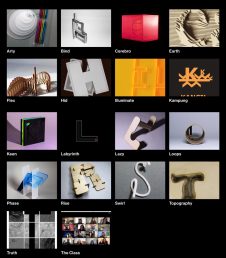Graphic design instructor ensures students’ online learning experience is ‘different and enjoyable’

Sharon Oiga remembers telling students in her graphic design classes that she would miss being in the classroom with them as they transitioned to online learning in March, but she offered them some words of encouragement.
“I told them that I’d miss our in-person interaction, but I was choosing to look forward to the new iteration of our class as an adventure,” said Oiga, associate professor and chair of graphic design in the School of Design within the College of Architecture, Design, and the Arts.
“I emphasized that this was an important moment in time, that we would rise to the challenges, and that we would be making history.”
And as far as history goes, Oiga and other teachers and students at the University of Illinois Chicago were indeed trailblazers.
Even though she had already been using Zoom and Slack Oiga knew that she would need to revise course plans and provide plenty of advance notice to the students of any tweaks.
Among her main goals was to not overwhelm her students, so she worked on developing instructions that were as simple and succinct as she could make them.
“I parceled the information into digestible portions under different channels,” she said.
Those channels included:
- Preparation for resuming classes online
- Class time protocol
- Weekly and daily schedules
- Assignments
- Year-end show
By the time students returned from spring break and into a new virtual reality, questions from students became minimal, and students and Oiga were ready to resume their work. By then, the online teaching took hold at UIC and across the country, and Oiga knew levity was in order.

“On that first day, I wore a silly pompom headband for a bit of comic relief,” Oiga said. “It made students laugh right upon joining the class in Zoom and seemed to put them at instant ease. I never would’ve worn the headband in person. I think the students knew that, and so it was a signal that this experience was going to be different and enjoyable.”
For a bit of fun this fall semester, she plans to provide some UIC-branded video backgrounds for the students’ optional use. In the Slack app, she’ll provide extra emojis — playful animated ones as well as the UIC logo in different colors. Within the app, she plans on creating a slew of automatic responses. For example, as an automatic response to each time “UIC” is mentioned in a chat, a confetti emoji will appear accompanied by the cheer, “Go UIC!”
One unexpected benefit to the new reality was that it seemed to allow the students, and even Oiga, to open up more than usual and everyone seemed more comfortable in front of the camera. Sometimes the conversations would veer off about their living situations or of a pet that made its way into view of the camera.
Also important was to acknowledge the difficult times they were all experiencing and the struggles they were enduring, but in a way that would not dwell on the negatives.
“It was my responsibility as the teacher as well as my regular practice to set an optimistic tone and high expectations for achievement, and to encourage and rally students to seize the day,” Oiga said.
She focused on the benefits of virtual learning both humorously and realistically with her students:
- There was zero commute time
- The prerogative to stay in sleepwear
- Ready access to their snacks
- Learn alternative ways of making and designing
- Practice communicating the way professional designers do with nonlocal clients
- Opportunity to create new, interesting and innovative project outcomes
On the last day of class, she made a point of applauding her students for their “amazing” final projects and they took the initiative to “applaud me, too,” she said.
“Of course I was touched,” she said. “Not only was I grateful but their words and sentiments affirmed what I was feeling — that teaching in this new mode was as successful and fulfilling as the traditional way and in some ways better.”
Categories
Faculty, Students, Top Faculty Staff News, Top Student News
Topics
CADA, COVID-19, design, elearning, online learning, sharon oiga
